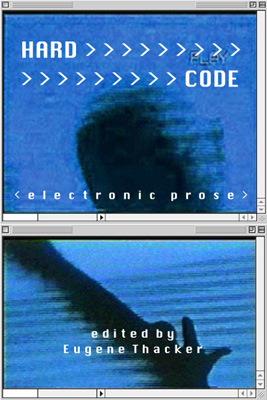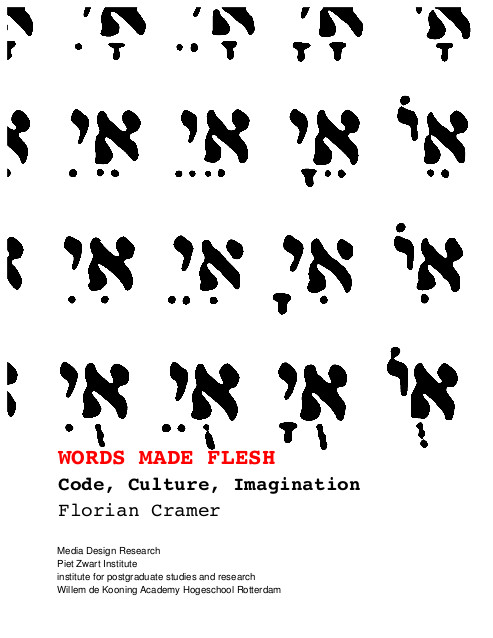David Link: Poesiemaschinen / Maschinenpoesie. Zur Frühgeschichte computerisierter Texterzeugung und generativer Systeme (2007) [German]
Filed under book | Tags: · algorithm, code poetry, digital poetry, poetry

Since the construction of the first computer in 1948, text is not only written and read, but also executed. Authors are now able to compose documents that produce content when run. “Poetry Machines / Machine Poetry” investigates the early history of these algorithmic artefacts in detail, traces them back to their literary predecessors, and emphasises the paradigms, contexts and phantasms that motivated and inspired them.
Computers are fundamentally alien to language. While Artificial Intelligence research in the 1960s and 1970s tried to overcome this difficulty unsuccessfully, text adventures used the same resistance playfully to enhance the suspense of the game. The book analyses variable scripts, Joseph Weizenbaum’s “Eliza”, Kenneth Colby’s “Parry”, early adventure games and Terry Winograd’s “SHRDLU” down to their source code, points out their metaphorical and logical structures, and places them in a genealogy of growing algorithmic complexity. The attempts are based on the belief that language and the knowledge about the world represented by it can be fully explained and even be formalised, emphatically advocated for instance in Ludwig Wittgenstein’s “Tractatus Logico-Philosophicus”. Technically, optional elements are arranged in tree-like structures and generate seemingly endless variance.
An antagonistic tradition of thought connects the dadaist Tristan Tzara, Claude E. Shannon’s re-discovery of the Russian mathematician Andrey A. Markov and the “Cut-Up” experiments of William S. Burroughs. It focuses on operations rather than on options and develops genuinely generative algorithms, which employ different routines to turn found material into collages and to produce effects unforeseen. The lacking machinic understanding of symbols transforms into poetry.
For principal reasons, the study of algorithms cannot proceed purely theoretically. As a concrete example of generative software, whose scope is by no means limited to the medium of text, Link gives an overview of a program he developed in the context of this research, “Poetry Machine”. The interactive text generator is based on semantic networks and acquires information about language autonomously from the internet. The translation of the fundamental text “An Example of Statistical Investigation of the Text ‘Eugene Onegin’ Concerning the Connection of Samples in Chains” by Andrey A. Markov, which can be regarded as the foundation of the generative approach, is given in the appendix.
Publisher Wilhelm Fink
151 pages
PDF (updated on 2014-8-29)
Comment (0)Eugene Thacker (ed.): Hard_code: Narrating the Network Society (2001)
Filed under book | Tags: · code poetry, network society

“HARD_CODE is an anthology of experimental electronic prose which asks the question: What kinds of stories are told by data? The texts in this anthology respond to this question from a wide range of viewpoints, often suggesting that the dynamics between bodies and data is not always a smooth one. Filled with identity avatars, DNA bodies, generative code, and virtual realities, HARD_CODE combines leading-edge work from new media art/net.art, cultural theory, and experimental fiction, forming new hybrids between flesh and data.
HARD_CODE brings together a group of innovative writers exploring the syntax of new media and computer technologies. From net.artists, to science fiction writers, to computer hackers, to practitioners of ‘degenerative prose,’ HARD_CODE is a ‘mis-users manual’ for the network society.”
Contributors include: Doll Yoko, Fakeshop, Matthew Fuller, Shelley Jackson, Harold Jaffe, ID_Runners, MEZ, Andi and Lance Olsen, Doug Rice, Steven Shaviro, Julia Solis, Alan Sondheim, Steve Tomasula, Don Webb, and many others…
Publisher Alt-X Press, 2001
ISBN 1931560048, 9781931560047
211 pages
PDF, PDF (updated on 2017-6-26)
Comment (0)Florian Cramer: Words Made Flesh: Code, Culture, Imagination (2005)
Filed under book | Tags: · art, art history, code, code poetry, computation, experimental literature, kabbalah, language, literature, philosophy, poetry, religion, software, software art, technology

“Executable code existed centuries before the invention of the computer in magic, Kabbalah, musical composition and experimental poetry. These practices are often neglected as a historical pretext of contemporary software culture and electronic arts. Above all, they link computations to a vast speculative imagination that encompasses art, language, technology, philosophy and religion. These speculations in turn inscribe themselves into the technology. Since even the most simple formalism requires symbols with which it can be expressed, and symbols have cultural connotations, any code is loaded with meaning. This booklet writes a small cultural history of imaginative computation, reconstructing both the obsessive persistence and contradictory mutations of the phantasm that symbols turn physical, and words are made flesh.”
Editor: Matthew Fuller, additional corrections: T. Peal
Published within Media Design Research programme, Piet Zwart Institute, Willem de Kooning Academy Hogeschool, Rotterdam
GNU General Public License 2; GNU Free Documentation License 1.2; Creative Commons Attribution-ShareAlike License 2.0
141 pages
Review: Tomáš Javůrek (Joinme, 2018, CZ).
PDF (updated on 2012-10-11)
HTML (added on 2013-7-1)
Sequel: Exe.cut(up)able statements: Poetische Kalküle und Phantasmen des selbstausführenden Texts (2011, in German).
Comment (0)
